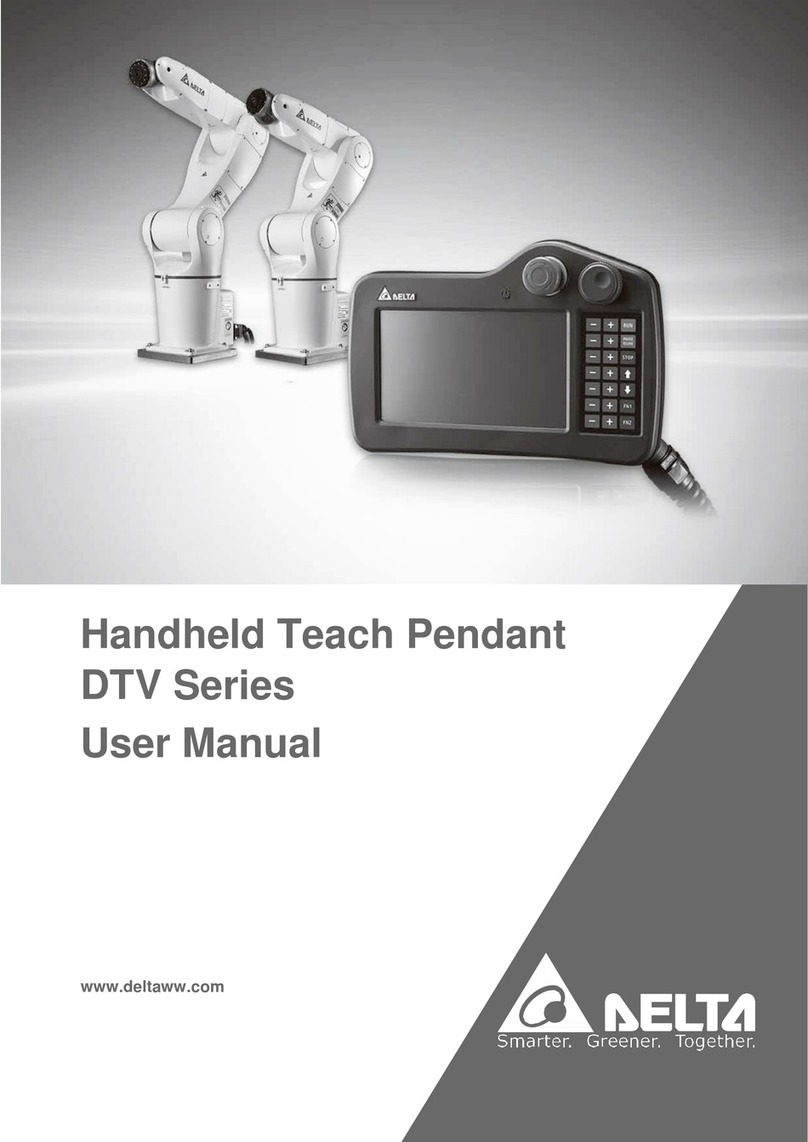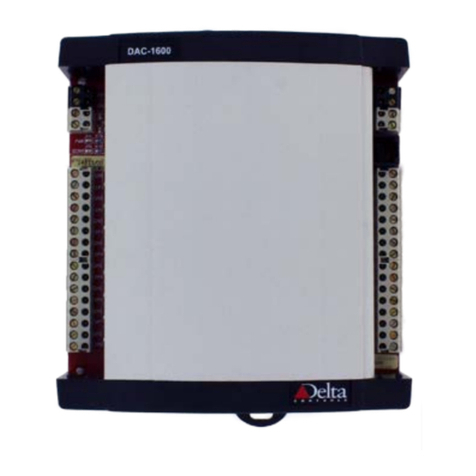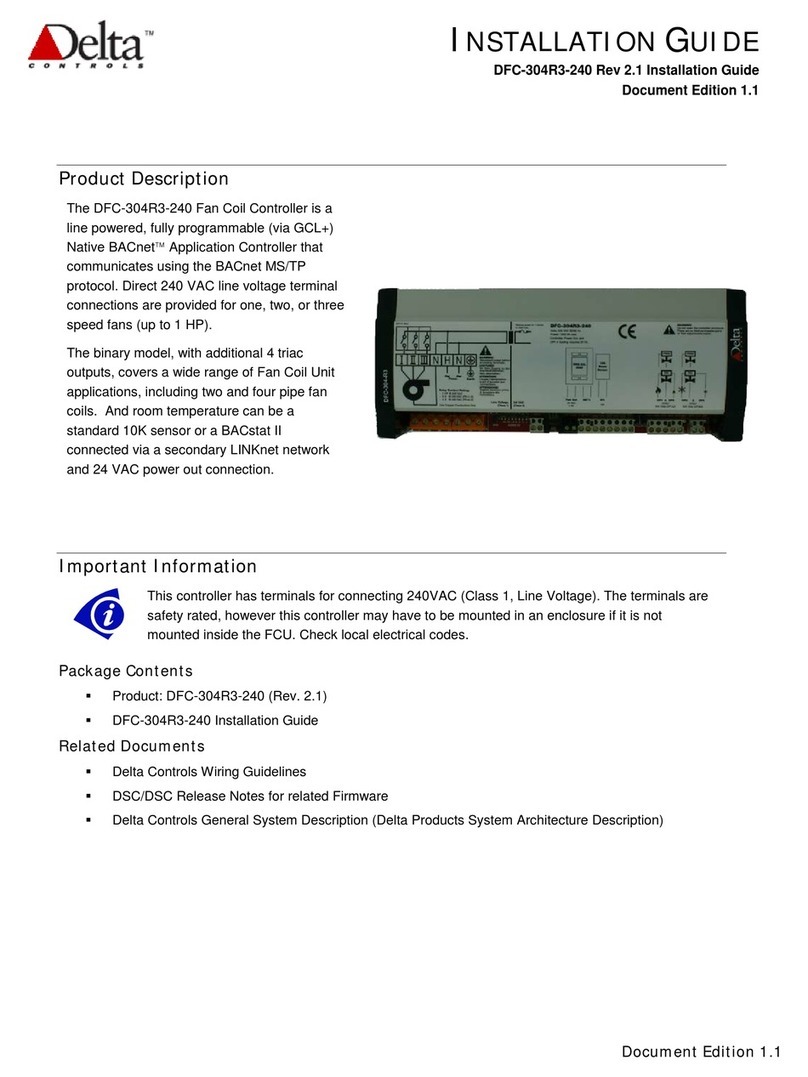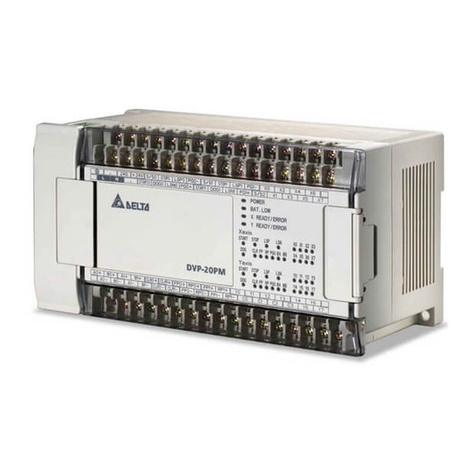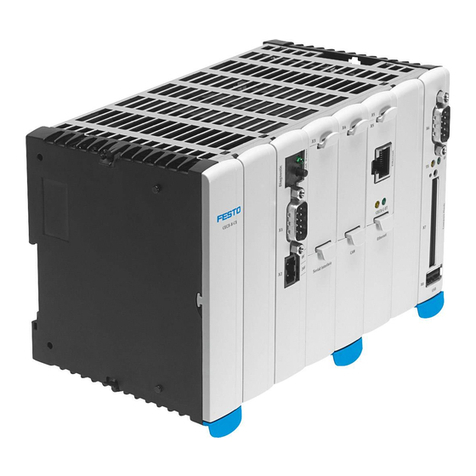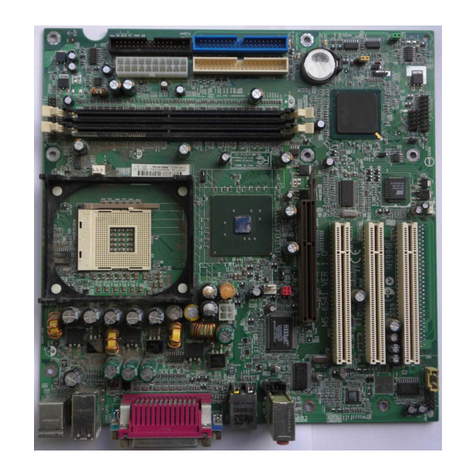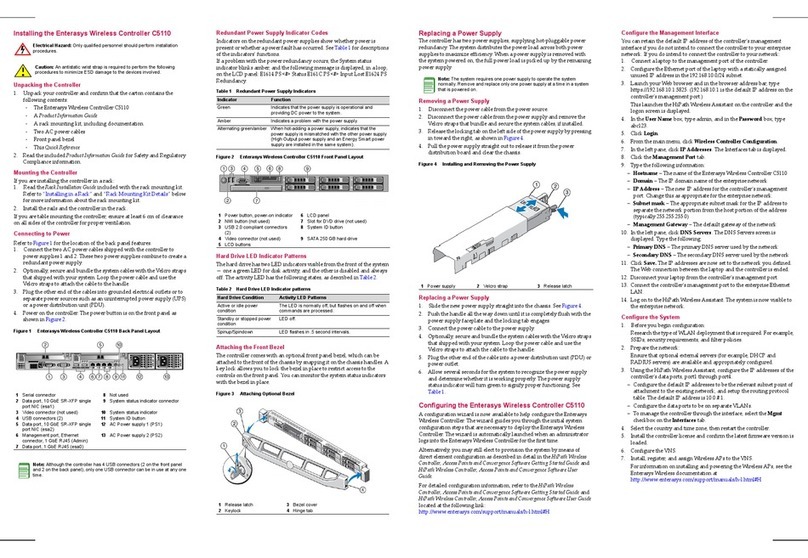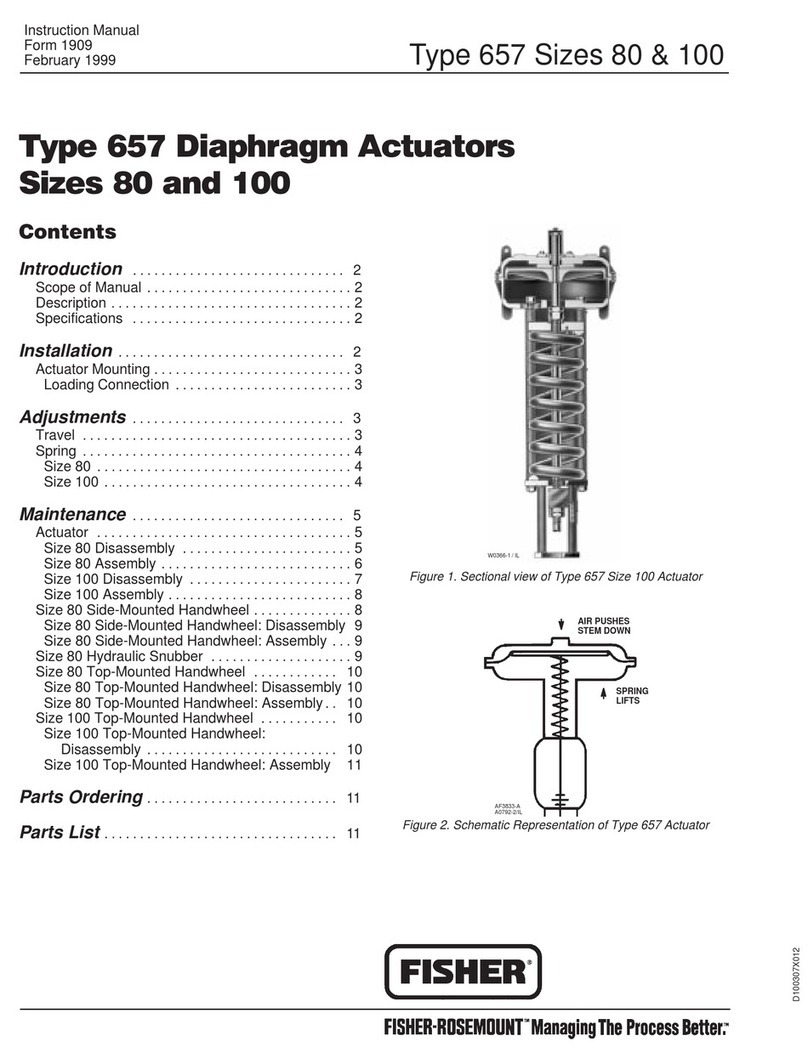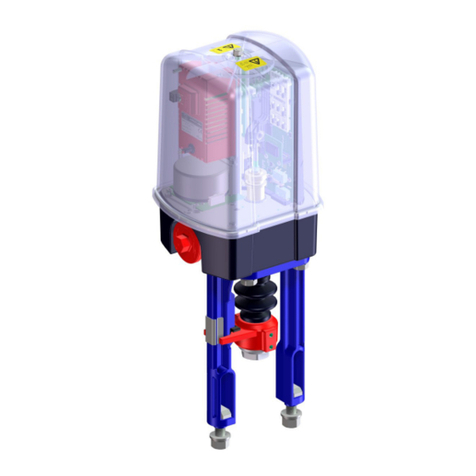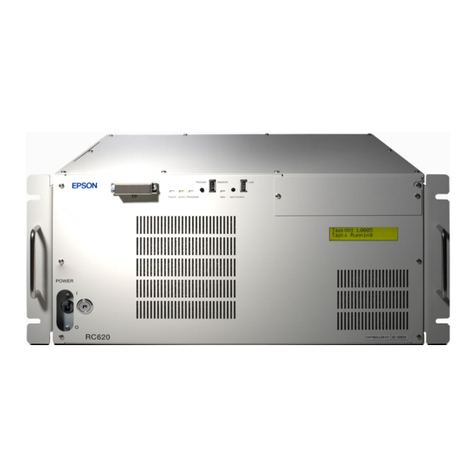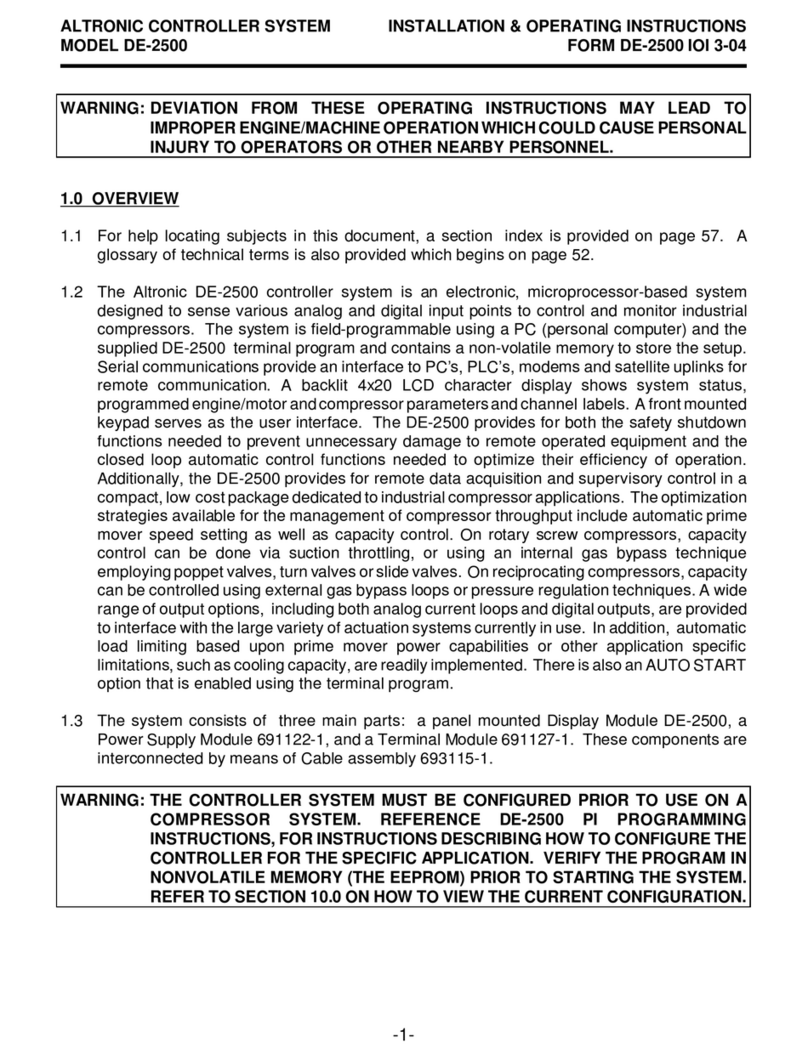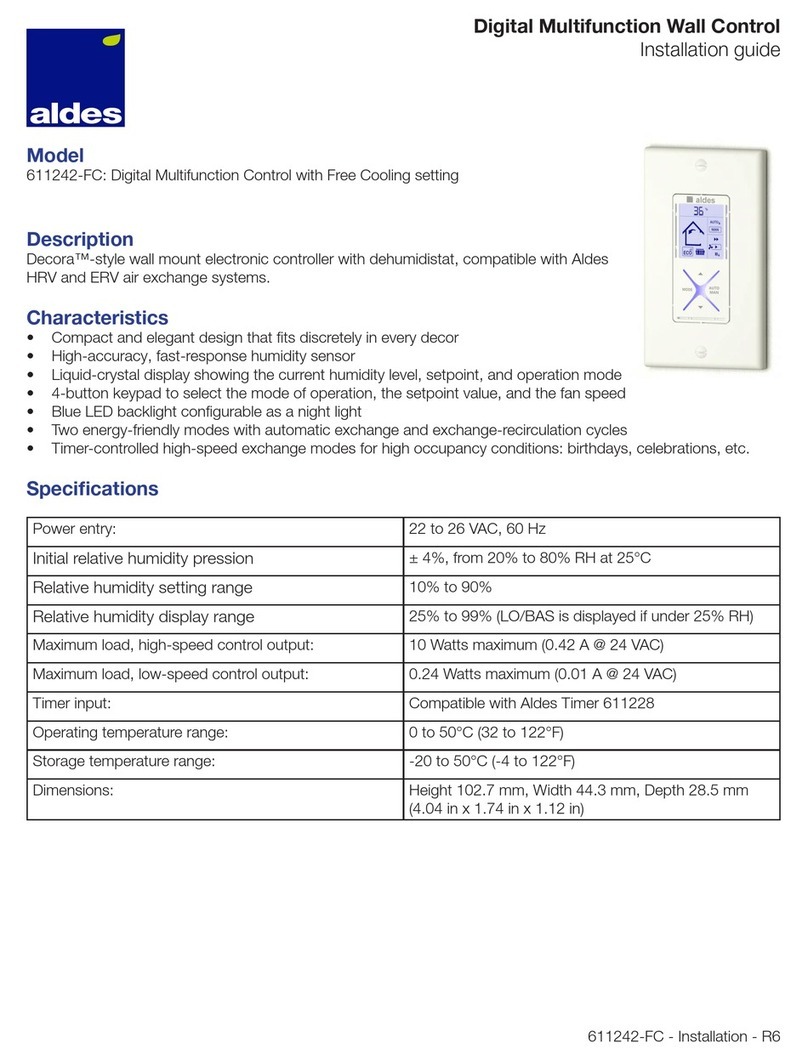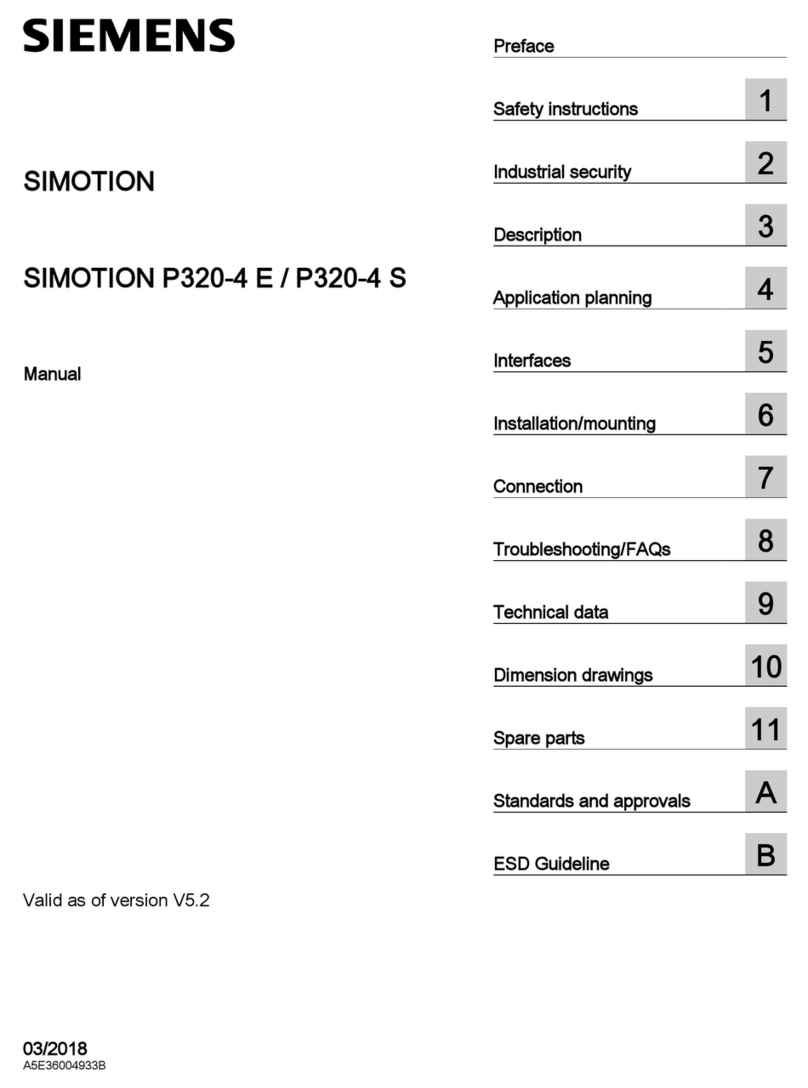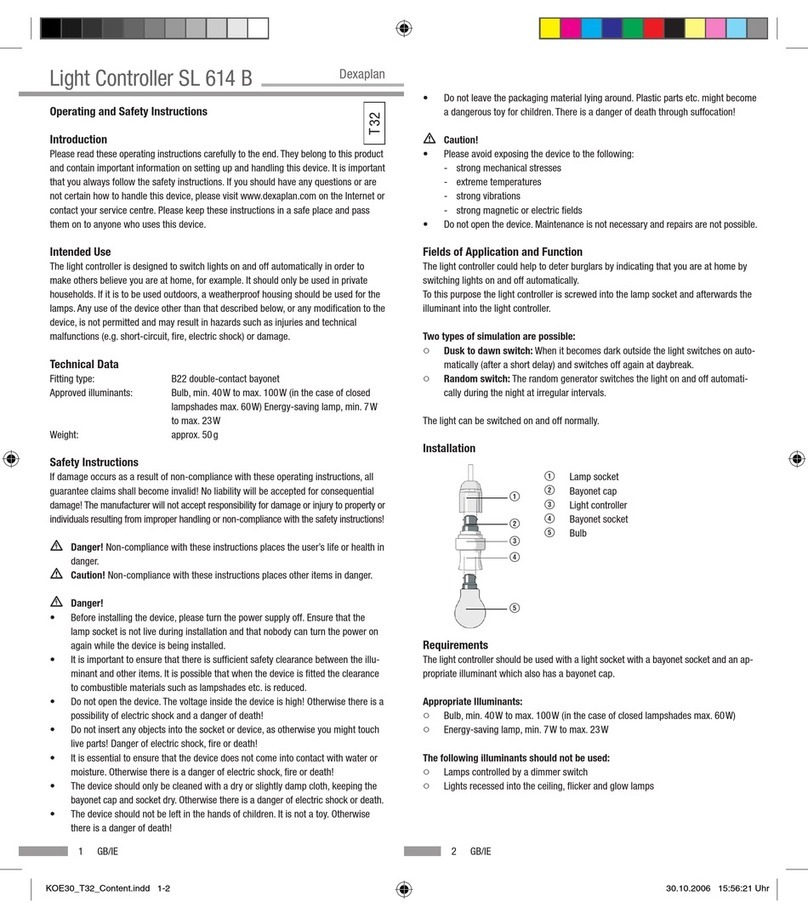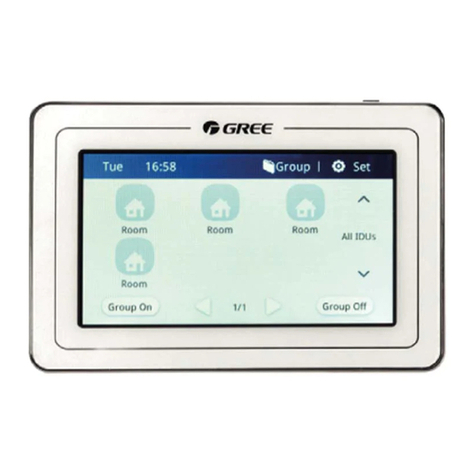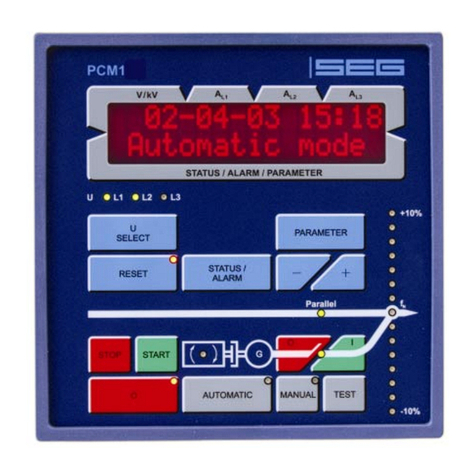Delta ASD-B2-0121-B User manual


Revision June 2010 i
Preface
Thank you very much for purchasing DELTA’s AC servo products.
This manual will be helpful in the installation, wiring, inspection, and operation of Delta AC
servo drive and motor. Before using the product, please read this user manual to ensure
correct use.
You should thoroughly understand all safety precautions (DANGERS, WARNINGS and STOPS)
before proceeding with the installation, wiring and operation. If you do not understand please
contact your local Delta sales representative. Place this user manual in a safe location for
future reference.
Using This Manual
Contents of this manual
This manual is a user guide that provides the information on how to install, operate
and maintain ASDA-B2 series AC servo drives and ECMA series AC servo motors. The
contents of this manual include the following topics:
zInstallation of AC servo drives and motors
zConfiguration and wiring
zTrial run steps
zControl functions and adjusting methods of AC servo drives
zParameter settings
zCommunication protocol
zInspection and maintenance
zTroubleshooting
zApplication examples
Who should use this manual
This manual is intended for the following users:
zThose who are responsible for designing
zThose who are responsible for installing or wiring
zThose who are responsible for operating or programming
zThose who are responsible for maintaining or troubleshooting
Important precautions
Before using the product, please read this user manual thoroughly to ensure correct
use. Store this manual in a safe and handy place for quick reference whenever
necessary. Always observe the following precautions:
zDo not use the product in a potentially explosive environment.
zInstall the product in a clean and dry location free from corrosive and
inflammable gases or liquids.

Preface
ii Revision June 2010
zDo not connect commercial power to the U, V, W terminals. Failure to observe
this precaution will cause severe damage to the Servo drive.
zEnsure that the motor and drive are correctly connected to a ground. The
grounding method must comply with the electrical standard of the country
(Please refer to NFPA 70: National Electrical Code, 2005 Ed.).
zDo not disconnect the AC servo drive and motor while the power is ON.
zDo not attach, modify or remove wiring while power is applied to the AC servo
drive.
zBefore starting the operation with a mechanical system connected, make sure
the emergency stop equipment can be energized and work at any time.
zDo not touch the drive heat sink or the servo motor during operation, this
may cause serious personnel injury.
PLEASE READ PRIOR TO INSTALLATION FOR SAFETY.
Carefully note and observe the following safety precautions when receiving, inspecting,
installing, operating, maintaining and troubleshooting. The following words, DANGER,
WARNING and STOP are used to mark safety precautions when using the Delta’s servo product.
Failure to observe these precautions may void the warranty!
ASDA-B2 series drives are open type servo drives and must be installed in an NEMA enclosure
such as a protection control panel during operation to comply with the requirements of the
international safety standards. They are provided with precise feedback control and high-
speed calculation function incorporating DSP (Digital Signal Processor) technology, and
intended to drive three-phase permanent magnet synchronous motors (PMSM) to achieve
precise positioning by means of accurate current output generated by IGBT (Insulated Gate
Bipolar Transistor).
ASDA-B2 series drives can be used in industrial applications and for installation in an end-use
enclosure that do not exceed the specifications defined in the ASDA-B2 series user manual
(Drives, cables and motors are for use in a suitable enclosure with a minimum of a UL50 type
1 or NEMA 250 Type 1 rating).
The words, DANGER, WARNING and STOP, have the following meaning:
Indicates a potentially hazardous situation and if not avoided, may result in
serious injury or death.
Indicates a potentially hazardous situation and if not avoided, may result in
minor to moderate injury or serious damage to the product.
Indicates an improper action that it is not recommended. Doing so may cause
damage or malfunction.

Preface
Revision June 2010 iii
Unpacking Check
¾Please ensure that both the servo drive and motor are correctly matched for size (power
rating). Failure to observe this precaution may cause fire, seriously damage to the drive
/ motor or cause personal injury.
Installation
¾Do not install the product in a location that is outside the stated specification for the
drive and motor. Failure to observe this caution may result in electric shock, fire, or
personal injury.
Wiring
¾Connect the ground terminals to a class-3 ground (Ground resistance should not exceed
100 Ω). Improper grounding may result in electric shock or fire.
¾Do not connect any power supplies to the U, V, W terminals. Failure to observe this
precaution may result in serious injury, damage to the drive or fire.
¾Ensure that all screws, connectors and wire terminations are secure on the power supply,
servo drive and motor. Failure to observe this caution may result in damage, fire or
personal injury.
Operation
¾Before starting the operation with a mechanical system connected, change the drive
parameters to match the user-defined parameters of the mechanical system. Starting the
operation without matching the correct parameters may result in servo drive or motor
damage, or damage to the mechanical system.
¾Ensure that the emergency stop equipment or device is connected and working correctly
before operating the motor that is connected to a mechanical system.
¾Do not approach or touch any rotating parts (e.g. shaft) while the motor is running.
Failure to observe this precaution may cause serious personal injury.
¾In order to prevent accidents, the initial trial run for servo motor should be conducted
under no load conditions (separate the motor from its couplings and belts).
¾For the initial trial run, do not operate the servo motor while it is connected to its
mechanical system. Connecting the motor to its mechanical system may cause damage or
result in personal injury during the trail run. Connect the servo motor once it has
successfully completed a trail run.
¾Caution: Please perform trial run without load first and then perform trial run with load
connected. After the servo motor is running normally and regularly without load, then
run servo motor with load connected. Ensure to perform trial run in this order to prevent
unnecessary danger.
¾Do not touch either the drive heat sink or the motor during operation as they may
become hot and personal injury may result.
Maintenance and Inspection
¾Do not touch any internal or exposed parts of servo drive and servo motor as electrical
shock may result.
¾Do not remove the operation panel while the drive is connected to an electrical power
source otherwise electrical shock may result.
¾Wait at least 10 minutes after power has been removed before touching any drive or
motor terminals or performing any wiring and/or inspection as an electrical charge may
still remain in the servo drive and servo motor with hazardous voltages even after power
has been removed.
¾Do not disassemble the servo drive or motor as electric shock may result.
¾Do not connect or disconnect wires or connectors while power is applied to the drive and
motor.
¾Only qualified personnel who have electrical knowledge should conduct maintenance and
inspection.

Preface
iv Revision June 2010
Main Circuit Wiring
¾Install the encoder cables in a separate conduit from the motor power cables to avoid
signal noise. Separate the conduits by 30cm (11.8inches) or more.
¾Use multi-stranded twisted-pair wires or multi-core shielded-pair wires for signal,
encoder (PG) feedback cables. The maximum length of command input cable is 3m
(9.84ft.) and the maximum length of encoder (PG) feedback cables is 20m (65.62ft.).
¾As a charge may still remain in the drive with hazardous voltages even after power has
been removed, be sure to wait at least 10 minutes after power has been removed before
performing any wiring and/or inspection.
¾It is not recommended to frequently power the drive on and off. Do not turn the drive off
and on more than once per minute as high charging currents within the internal
capacitors may cause damage.
Main Circuit Terminal Wiring
¾Please perform the wiring after the terminal blocks are all removed from the drive.
¾Insert only one wire into one terminal on the terminal block.
¾When inserting wires, please ensure that the conductors are not shorted to adjacent
terminals or wires.
¾Ensure to double check the wiring before applying power to the drive.
¾If the wiring is in error, perform the wiring again with proper tools. Never use force to
remove the terminals or wires. Otherwise, it may result in malfunction or damage.
NOTE
1) In this manual, actual measured values are in metric units. Dimensions in
(imperial units) are for reference only. Please use metric units for precise
measurements.
2) The content of this manual may be revised without prior notice. Please
consult our distributors or download the most updated version at
http://www.delta.com.tw/industrialautomation.
.

Revision June 2010 v
Table of Contents
Chapter 1 Unpacking Check and Model Explanation............................................... 1-1
1.1 Unpacking Check................................................................................................ 1-1
1.2 Model Explanation .............................................................................................. 1-2
1.2.1 Nameplate Information .............................................................................. 1-2
1.2.2 Model Name Explanation ........................................................................... 1-3
1.3 Servo Drive and Servo Motor Combinations ........................................................ 1-5
1.4 Servo Drive Features ........................................................................................... 1-6
1.5 Control Modes of Servo Drive ............................................................................. 1-7
Chapter 2 Installation and Storage ......................................................................... 2-1
2.1 Installation Notes................................................................................................ 2-1
2.2 Storage Conditions ............................................................................................. 2-1
2.3 Installation Conditions........................................................................................ 2-2
2.4 Installation Procedure and Minimum Clearances ................................................. 2-3
2.5 Molded-case Circuit Breaker and Fuse Current Recommended Value................... 2-5
2.6 EMI Filter Selection.............................................................................................. 2-6
2.7 Regenerative Resistor ......................................................................................... 2-9
Chapter 3 Connections and Wiring......................................................................... 3-1
3.1 Connections ....................................................................................................... 3-1
3.1.1 Connecting to Peripheral Devices............................................................... 3-1
3.1.2 Servo Drive Connectors and Terminals....................................................... 3-2
3.1.3 Wiring Methods ......................................................................................... 3-5

Table of Contents
vi Revision June 2010
3.1.4 Motor Power Cable Connector Specifications ............................................. 3-7
3.1.5 Encoder Connector Specifications .............................................................. 3-9
3.1.6 Cable Specifications for Servo Drive ........................................................... 3-10
3.2 Basic Wiring ........................................................................................................ 3-12
3.3 Input / Output Interface Connector - CN1 ........................................................... 3-16
3.3.1 CN1 Terminal Identification ....................................................................... 3-16
3.3.2 Signals Explanation of Connector - CN1..................................................... 3-18
3.3.3 User-defined DI and DO signals ................................................................. 3-27
3.3.4 Wiring Diagrams of I/O Signals - CN1 ........................................................ 3-32
3.4 Encoder Connector - CN2.................................................................................... 3-33
3.5 Serial Communication Connector - CN3 .............................................................. 3-34
3.5.1 Terminal Layout and Identification – CN3 .................................................. 3-34
3.5.2 Connection between PC and Connector - CN3............................................ 3-35
3.6 Standard Connection Example ............................................................................ 3-36
3.6.1 Position (PT) Control Mode ........................................................................ 3-36
3.6.2 Speed Control Mode .................................................................................. 3-37
3.6.3 Torque Control Mode................................................................................. 3-38
Chapter 4 Display and Operation ........................................................................... 4-1
4.1 Description of Digital Keypad ............................................................................. 4-1
4.2 Display Flowchart ............................................................................................... 4-2
4.3 Status Display ..................................................................................................... 4-3
4.3.1 Save Setting Display................................................................................... 4-3
4.3.2 Abort Setting Display ................................................................................. 4-3

Table of Contents
Revision June 2010 vii
4.3.3 Fault Message Display ............................................................................... 4-3
4.3.4 Polarity Setting Display .............................................................................. 4-3
4.3.5 Monitor Setting Display ............................................................................. 4-4
4.4 General Function Operation ................................................................................ 4-7
4.4.1 Fault Code Display Operation .................................................................... 4-7
4.4.2 JOG Operation ........................................................................................... 4-8
4.4.3 Force Output Control Operation ................................................................ 4-9
4.4.4 DI Diagnosis Operation.............................................................................. 4-10
4.4.5 DO Diagnosis Operation ............................................................................ 4-11
Chapter 5 Trial Run and Tuning Procedure............................................................. 5-1
5.1 Inspection without Load...................................................................................... 5-1
5.2 Applying Power to the Drive................................................................................ 5-3
5.3 JOG Trial Run without Load ................................................................................. 5-7
5.4 Speed Trial Run without Load ............................................................................. 5-9
5.5 Tuning Procedure ............................................................................................... 5-11
5.5.1 Tuning Flowchart....................................................................................... 5-12
5.5.2 Load Inertia Estimation Flowchart .............................................................. 5-13
5.5.3 Auto Mode Tuning Flowchart ..................................................................... 5-14
5.5.4 Semi-Auto Mode Tuning Flowchart............................................................. 5-15
5.5.5 Limit of Load Inertia Estimation ................................................................. 5-17
5.5.6 Mechanical Resonance Suppression Method .............................................. 5-19
5.5.7 Relationship between Tuning Modes and Parameters................................. 5-20
5.5.8 Gain Adjustment in Manual Mode .............................................................. 5-21

Table of Contents
viii Revision June 2010
Chapter 6 Control Modes of Operation .................................................................. 6-1
6.1 Control Modes of Operation................................................................................ 6-1
6.2 Position Control Mode ........................................................................................ 6-2
6.2.1 Command Source of Position (PT) Control Mode ........................................ 6-2
6.2.2 Structure of Position Control Mode ............................................................ 6-4
6.2.3 Electronic Gear Ratio.................................................................................. 6-5
6.2.4 Low-pass Filter........................................................................................... 6-5
6.2.5 Position Loop Gain Adjustment.................................................................. 6-7
6.3 Speed Control Mode ........................................................................................... 6-10
6.3.1 Command Source of Speed Control Mode .................................................. 6-10
6.3.2 Structure of Speed Control Mode ............................................................... 6-11
6.3.3 Smoothing Strategy of Speed Control Mode ............................................... 6-12
6.3.4 Analog Speed Input Scaling ....................................................................... 6-16
6.3.5 Timing Chart of Speed Control Mode ......................................................... 6-17
6.3.6 Speed Loop Gain Adjustment..................................................................... 6-18
6.3.7 Resonance Suppression ............................................................................. 6-25
6.4 Torque Control Mode.......................................................................................... 6-32
6.4.1 Command Source of Torque Control Mode ................................................ 6-32
6.4.2 Structure of Torque Control Mode ............................................................. 6-33
6.4.3 Smoothing Strategy of Torque Control Mode ............................................. 6-34
6.4.4 Analog Torque Input Scaling...................................................................... 6-34
6.4.5 Timing Chart of Torque Control Mode ....................................................... 6-35
6.5 Control Mode Selection....................................................................................... 6-36

Table of Contents
Revision June 2010 ix
6.5.1 Speed / Position Control Mode Selection.................................................... 6-36
6.5.2 Speed / Torque Control Mode Selection..................................................... 6-37
6.5.3 Torque / Position Control Mode Selection.................................................. 6-37
6.6 Others ................................................................................................................ 6-38
6.6.1 Speed Limit................................................................................................ 6-38
6.6.2 Torque Limit.............................................................................................. 6-38
6.6.3 Analog Monitor.......................................................................................... 6-39
6.6.4 Electromagnetic Brake ............................................................................... 6-42
Chapter 7 Parameters ............................................................................................ 7-1
7.1 Definition ........................................................................................................... 7-1
7.2 Parameter Summary............................................................................................ 7-2
7.3 Detailed Parameter Listings ................................................................................ 7-11
Chapter 8 MODBUS Communications ..................................................................... 8-1
8.1 Communication Hardware Interface .................................................................... 8-1
8.2 Communication Parameter Settings .................................................................... 8-4
8.3 MODBUS Communication Protocol ...................................................................... 8-8
8.4 Communication Parameter Write-in and Read-out ............................................... 8-16
Chapter 9 Maintenance and Inspection .................................................................. 9-1
9.1 Basic Inspection .................................................................................................. 9-1
9.2 Maintenance ....................................................................................................... 9-2
9.3 Life of Replacement Components........................................................................ 9-3
Chapter 10 Troubleshooting ................................................................................ 10-1
10.1 Fault Messages Table........................................................................................ 10-1

Table of Contents
x Revision June 2010
10.2 Potential Cause and Corrective Actions ............................................................. 10-3
10.3 Clearing Faults.................................................................................................. 10-11
Chapter 11 Specifications..................................................................................... 11-1
11.1 Specifications of Servo Drive (ASDA-B2 Series)................................................... 11-1
11.2 Specifications of Servo Motor (ECMA Series)...................................................... 11-3
11.3 Servo Motor Speed-Torque Curves .................................................................... 11-8
11.4 Overload Characteristics ................................................................................... 11-9
11.5 Dimensions of Servo Drive ................................................................................ 11-11
11.6 Dimensions of Servo Motor ............................................................................... 11-15
Appendix A Accessories ........................................................................................ A-1

Table of Contents
Revision June 2010 xi
About this Manual…
User Information
Be sure to store this manual in a safe place.
Due to constantly growing product range, technical improvement, alteration or changed texts,
figures and diagrams, we reserve the right to make information changes within this manual
without prior notice.
Coping or reproducing any part of this manual, without written consent of Delta Electronics
Inc. is prohibited.
Technical Support and Service
You are welcome to contact our Technical Support Team at the below numbers or visit our
web site (http://www.delta.com.tw/industrialautomation/) if you need technical support,
service, information, or if you have any questions in the use of this product. We look forward
to serving your needs and are willing to offer our best support and service to you.
ASIA
DELTA ELECTRONICS, INC.
Taoyuan Plant 1
31-1, XINGBANG ROAD,
GUISHAN INDUSTRIAL ZONE,
TAOYUAN COUNTY 33370, TAIWAN, R.O.C.
TEL: 886-3-362-6301
FAX: 886-3-362-7267
NORTH/SOUTH AMERICA
DELTA PRODUCTS CORPORATION (USA)
Raleigh Office
P.O. BOX 12173
5101 DAVIS DRIVE,
RESEARCH TRIANGLE PARK, NC 27709,
U.S.A.
TEL: 1-919-767-3813
FAX: 1-919-767-3969
JAPAN
DELTA ELECTRONICS (JAPAN), INC.
Tokyo Office
DELTA SHIBADAIMON BUILDING
2-1-14 SHIBADAIMON, MINATO-KU,
TOKYO, 105-0012, JAPAN
TEL: 81-3-5733-1111
FAX: 81-3-5733-1211
EUROPE
DELTRONICS (THE NETHERLANDS) B.V.
Eindhoven Office
DE WITBOGT 15, 5652 AG EINDHOVEN,
THE NETHERLANDS
TEL: 31-40-259-2850
FAX: 31-40-259-2851

Table of Contents
xii Revision June 2010
This page intentionally left blank.

Revision June 2010 1-1
Chapter 1 Unpacking Check and Model Explanation
1.1 Unpacking Check
After receiving the AC servo drive, please check for the following:
Ensure that the product is what you have ordered.
Verify the part number indicated on the nameplate corresponds with the part number of
your order (Please refer to Section 1.2 for details about the model explanation).
Ensure that the servo motor shaft rotates freely.
Rotate the motor shaft by hand; a smooth rotation will indicate a good motor. However, a
servo motor with an electromagnetic brake can not be rotated manually.
Check for damage.
Inspect the unit to insure it was not damaged during shipment.
Check for loose screws.
Ensure that all necessary screws are tight and secure.
If any items are damaged or incorrect, please inform the distributor whom you purchased the
product from or your local Delta sales representative.
A complete and workable AC servo system should include the following parts:
Part I : Delta standard supplied parts
(1) Servo drive
(2) Servo motor
(3) 5 PIN Terminal Block (for L1c, L2c, R, S, T)
(4) 3 PIN Terminal Block (for U, V, W)
(5) 4 PIN Terminal Block (for P , D, C, )
(6) One operating lever (for wire to terminal block insertion)
(7) One jumper bar (installed at pins P and D of the 3 PIN Terminal Block for P , D, C)
(8) Instruction Sheets
Part II : Optional parts (Refer to Appendix A)
(1) One power cable, which is used to connect servo motor to U, V, W terminals of servo
drive. This power cable includes a green grounding cable. Please connect the green
grounding cable to the ground terminal of the servo drive.

Chapter 1 Unpacking Check and Model Explanation
1-2 Revision June 2010
(2) One encoder cable, which is used to connect the encoder of servo motor to the CN2
terminal of servo drive.
(3) CN1 Connector: 4 PIN Connector (3M type analog product)
(4) CN2 Connector: 9 PIN Connector (3M type analog product)
(5) CN3 Connector: 6 PIN Connector (IEEE1394 analog product)
1.2 Model Explanation
1.2.1 Nameplate Information
ASDA-B2 Series Servo Drive
Nameplate Explanation
Serial Number Explanation
ASMT Series Servo Motor
Nameplate Explanation
Serial Number Explanation

Chapter 1 Unpacking Check and Model Explanation
Revision June 2010 1-3
1.2.2 Model Name Explanation
ASDA-B2 Series Servo Drive

Chapter 1 Unpacking Check and Model Explanation
1-4 Revision June 2010
ECMA Series Servo Motor

Chapter 1 Unpacking Check and Model Explanation
Revision June 2010 1-5
1.3 Servo Drive and Servo Motor Combinations
The table below shows the possible combination of Delta ASDA-B2 series servo drives and
ECMA series servo motors. The boxes () in the model names are for optional configurations.
(Please refer to Section 1.2 for model explanation)
Power Servo Drive Servo Motor
100W ASD-B2-0121-B
ECMA-C20401S(S=8mm)
200W ASD-B2-0221-B ECMA-C20602S(S=14mm)
400W ASD-B2-0421-B
ECMA-C20604S (S=14mm)
ECMA-CM0604S (S=14mm)
ECMA-C208047 (7=14mm)
ECMA-E21305S (S=22mm)
ECMA-G21303S (S=22mm)
750W ASD-B2-0721-B
ECMA-C20807S (S=19mm)
ECMA-C20907S (S=16mm)
ECMA-G21306S (S=22mm)
ECMA-GM1306S (S=22mm)
1000W ASD-B2-1021-B
ECMA-C21010S (S=22mm)
ECMA-C20910S (S=16mm)
ECMA-E21310S (S=22mm)
ECMA-G21309S (S=22mm)
ECMA-GM1309S (S=22mm)
1500W ASD-B2-1521-B ECMA-E21315S (S=22mm)
2000W ASD-B2-2023-B
ECMA-C21020S (S=22mm)
ECMA-E21320S (S=22mm)
ECMA-E21820S (S=35mm)
3000W ASD-B2-3023-B ECMA-E21830S (S=35mm)
ECMA-F21830S (S=35mm)
The servo drives shown in the above table are designed for use in combination with the
specific servo motors. Check the specifications of the drives and motors you want to use.
Also, please ensure that both the servo drive and motor are correctly matched for size (power
rating). If the power of motor and drive is not within the specifications, the drive and motor
may overheat and servo alarm would be activated. For the detail specifications of servo drives
and motors, please refer to Chapter 11 “Specifications”.
The drives shown in the above table are designed according to the three multiple of rated
current of motors shown in the above table. If the drives which are designed according to the
six multiple of rated current of motors are needed, please contact our distributors or your
local Delta sales representative.

Chapter 1 Unpacking Check and Model Explanation
1-6 Revision June 2010
1.4 Servo Drive Features

Chapter 1 Unpacking Check and Model Explanation
Revision June 2010 1-7
1.5 Control Modes of Servo Drive
The Delta Servo provides six single and five dual modes of operation.
Their operation and description is listed in the following table.
Mode Code
Description
External Position Control P External Position control mode for the servo motor
is achieved via an external pulse command.
Speed Control S
(External / Internal) Speed control mode for the
servo motor can be achieved via parameters set
within the controller or from an external analog -10
~ +10 VDC command. Control of the internal speed
mode is via the Digital Inputs (DI). (A maximum of
three speeds can be stored internally).
Internal Speed Control Sz
Internal Speed control mode for the servo motor is
only achieved via parameters set within the
controller. Control of the internal speed mode is via
the Digital Inputs (DI). (A maximum of three speeds
can be stored internally).
Torque Control T
(External / Internal) Torque control mode for the
servo motor can be achieved via parameters set
within the controller or from an external analog -10
~ +10 VDC command. Control of the internal torque
mode is via the Digital Inputs (DI). (A maximum of
three torque levels can be stored internally).
Single
Mode
Internal Torque Control
Tz Internal Torque control mode for the servo motor is
only achieved via parameters set within the
controller. Control of the internal torque mode is
via the Digital Inputs (DI). (A maximum of three
torque levels can be stored internally).
S-P Either S or P control mode can be selected via the
Digital Inputs (DI)
T-P Either T or P control mode can be selected via the
Digital Inputs (DI)
Dual Mode
S-T Either S or T control mode can be selected via the
Digital Inputs (DI)
The above control modes can be accessed and changed via parameter P1-01. Enter the new
control mode via P1-01 then switch the main power to the servo drive OFF then ON. The new
control mode will only be valid after the drives main power is switched OFF then ON. Please
see safety precautions on page iii (switching drive off/on multiple times).
This manual suits for next models
7
Table of contents
Other Delta Controllers manuals
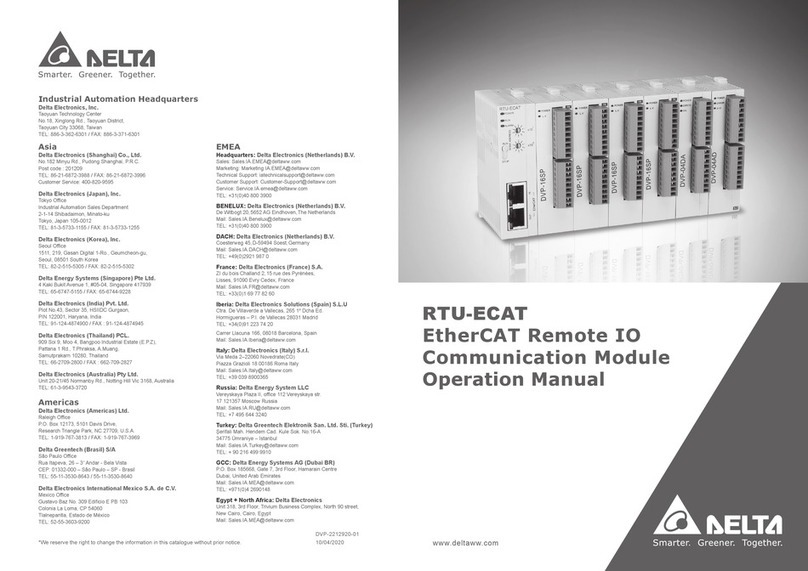
Delta
Delta RTU-ECAT User manual
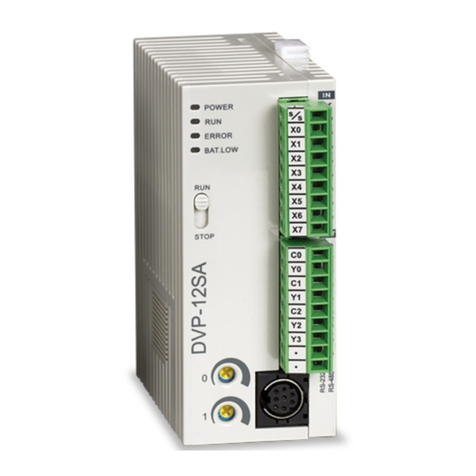
Delta
Delta DVP08SM11N User manual

Delta
Delta DVP-20PM User manual
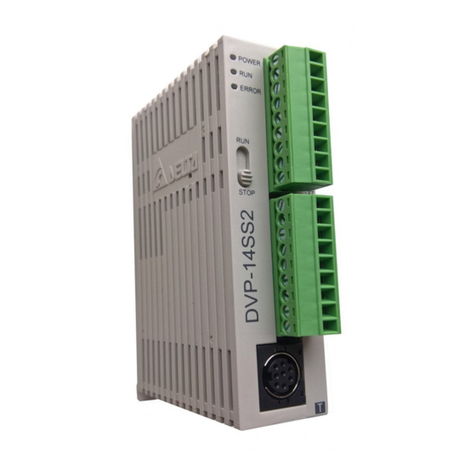
Delta
Delta DVP08SM11N User manual
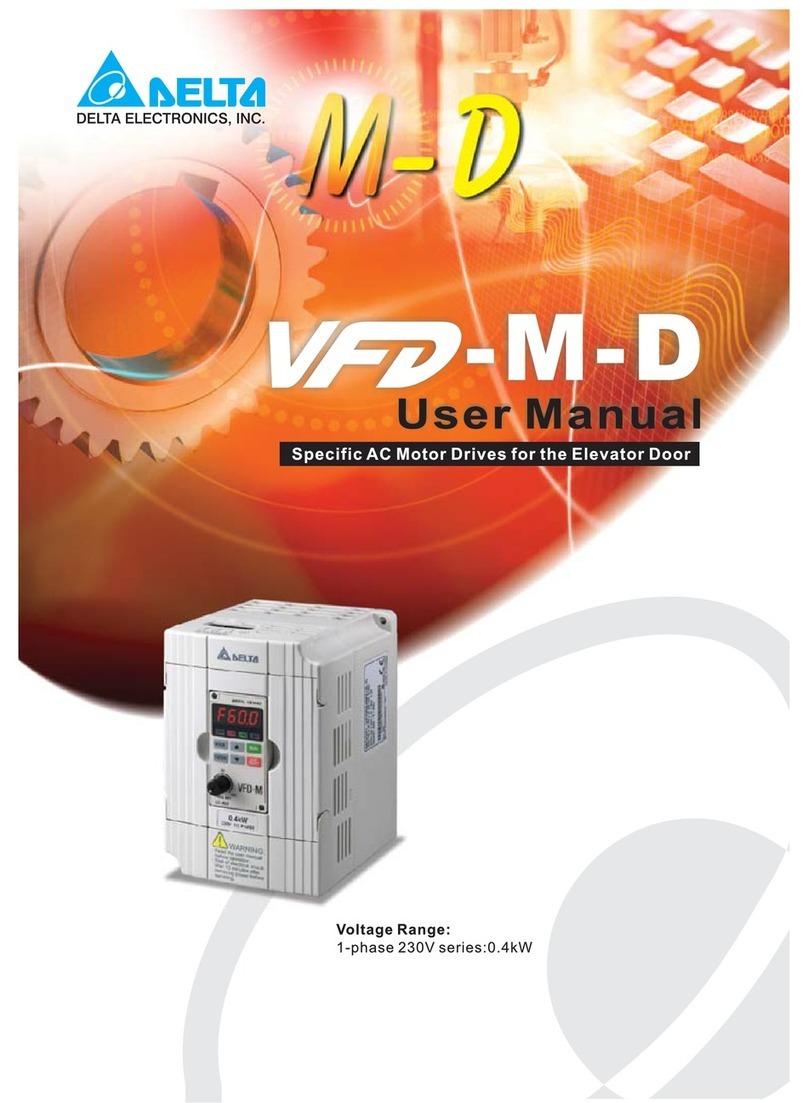
Delta
Delta VFD-M-D series User manual
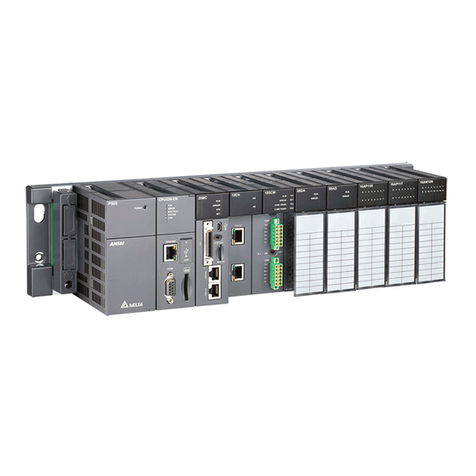
Delta
Delta AH500 series User manual
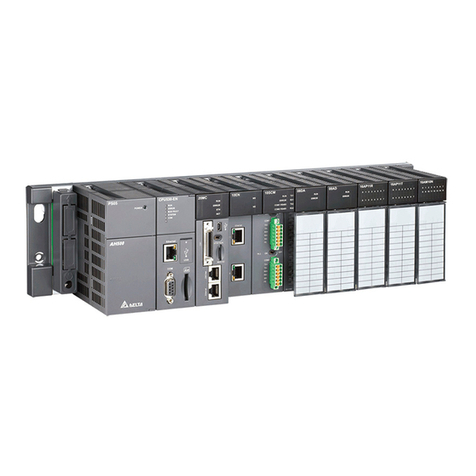
Delta
Delta AH500 series User manual
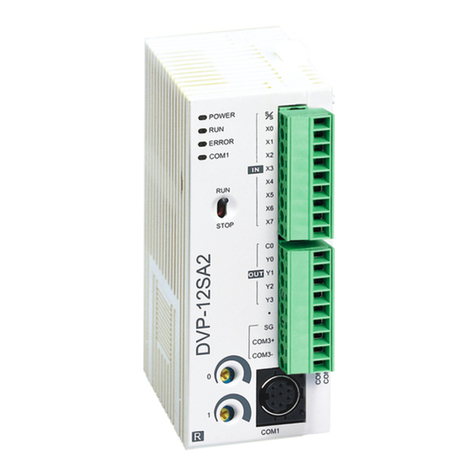
Delta
Delta DVP-SA2 User manual

Delta
Delta RMC70 User guide

Delta
Delta DVP-SX2 User manual
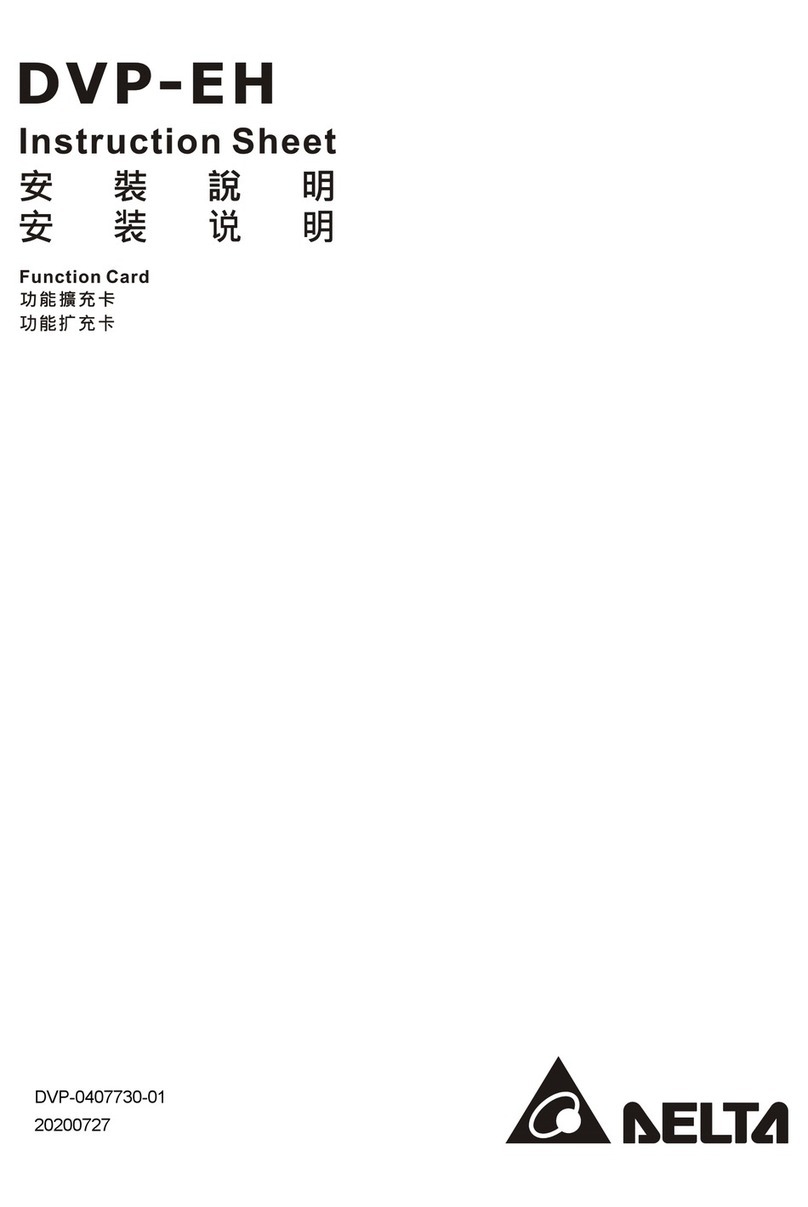
Delta
Delta DVP-EH Series User manual
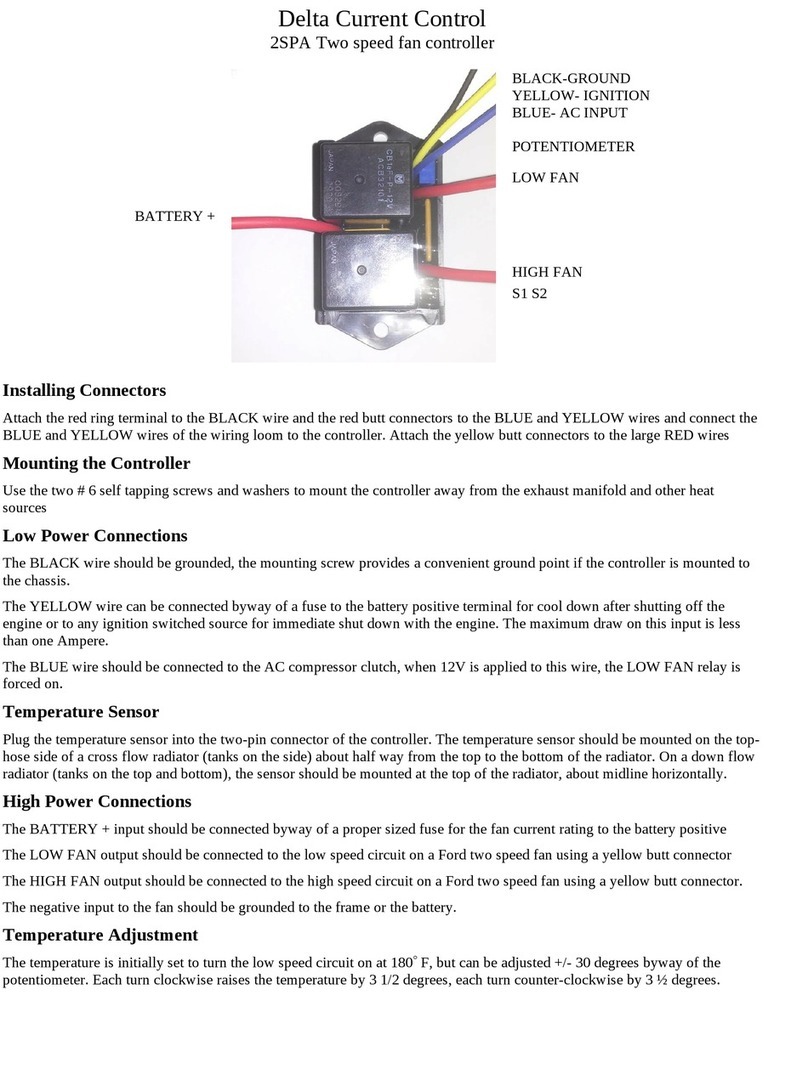
Delta
Delta 2SPA User manual
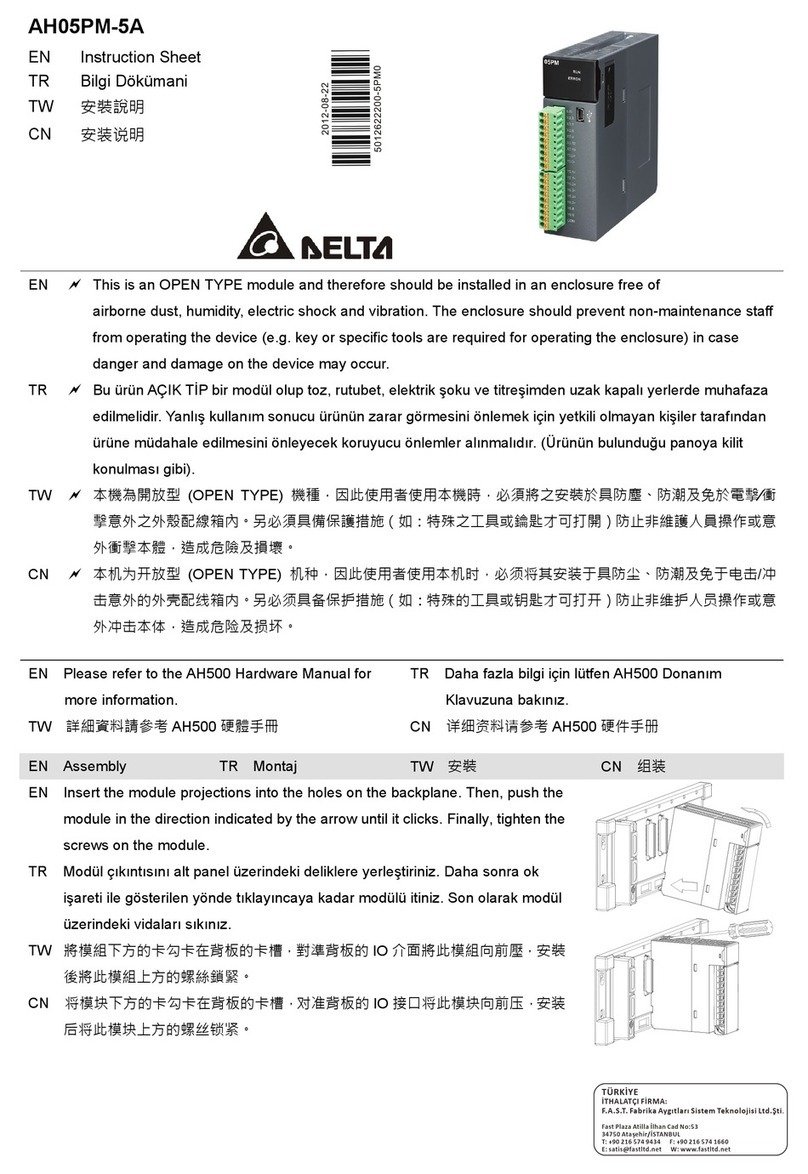
Delta
Delta AH05PM-5A User manual
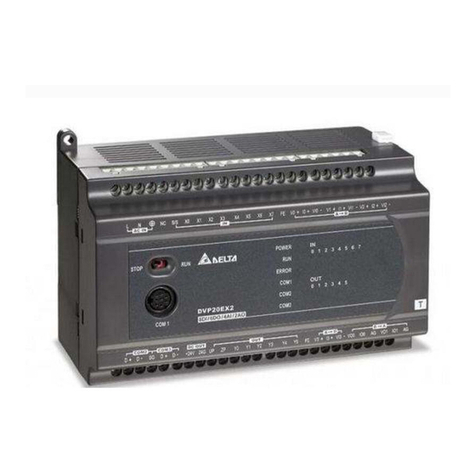
Delta
Delta DVP30EX2 User manual
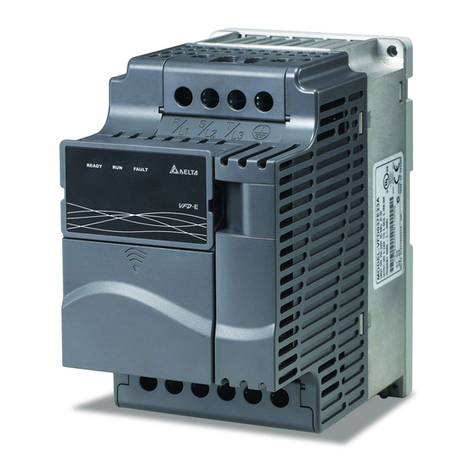
Delta
Delta VFD-E User manual
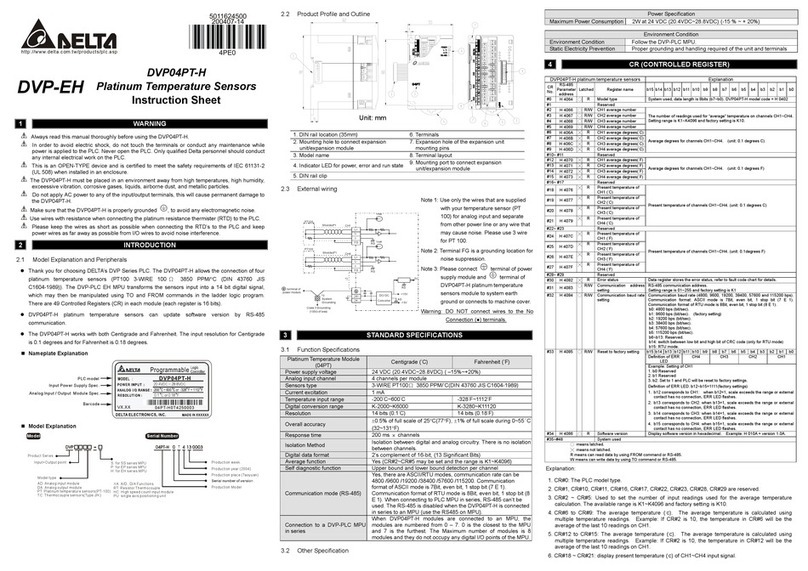
Delta
Delta DVP-EH User manual
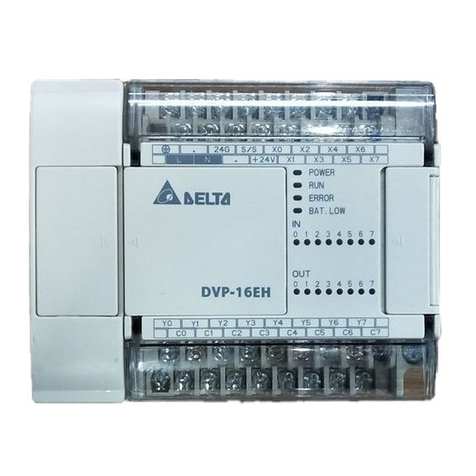
Delta
Delta DVP-EH2 Series User manual
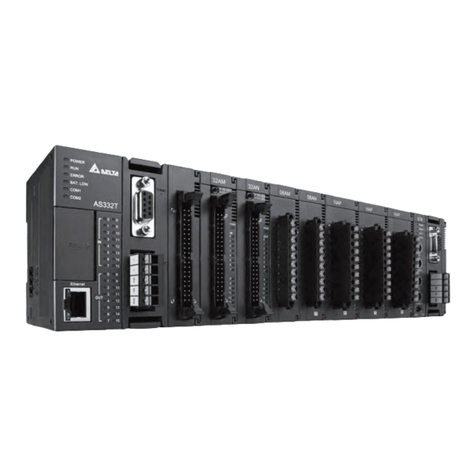
Delta
Delta AS Series User manual
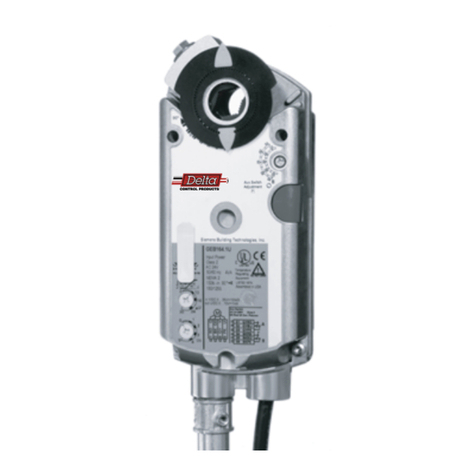
Delta
Delta DC-132 Series User manual
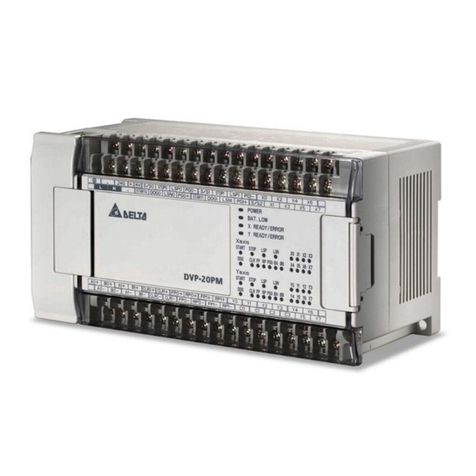
Delta
Delta DVP-20PM Instructions for use
